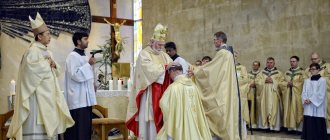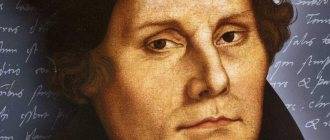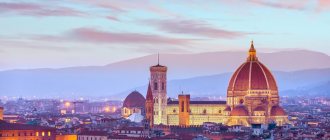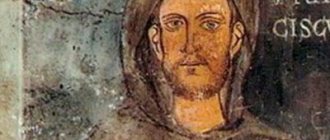.
.
1. The doctrine of the procession of the Holy Spirit not only from God the Father, but “also from the Son” (Filioque).
2. A distortion of the teaching about the Church, generated by the supreme power over it of the Bishop of Rome, and the doctrine of his teaching infallibility.
3. A distortion of the relationship between God and man, manifested in the Roman Catholic view of original sin, man's salvation and his afterlife.
4. The doctrine of the immaculate conception of the Virgin Mary and her bodily ascension to heaven are marial dogmas.
5. The idea of the independent action of God's grace in the sacraments (opus operatum), reflected in the teaching on the sacraments and worship of the Roman Catholic Church.
6. Special teaching about Holy Scripture and Holy Tradition.
.
.
St. Peter's Basilica is a Catholic cathedral, the central and largest building of the Vatican, the largest historical Christian church in the world. One of the four patriarchal basilicas of Rome and the ceremonial center of the Roman Catholic Church. Several generations of great masters worked on its creation: Bramante, Raphael, Michelangelo, Bernini. Capacity approximately 60,000 people .
.
Features of Roman Catholic ecclesiology and the doctrine of the supreme ecclesiastical authority of the Bishop of Rome
.
To get closer to understanding Catholicism, it is necessary to find out the basic internal principle, the general source of its religious development. The Orthodox view traditionally notes in the religious consciousness of the Catholic West the predominance of the rational principle, the inclination towards the intelligibility of faith and church life, which Prof. A. Katansky defined it as the desire to objectify Christianity, i.e. to make it completely accessible to human perception, to reduce the heavenly to earthly tangibility.
.
This desire comes from the natural weakness of human consciousness, which more easily perceives the visible manifestations of the invisible Divine existence and strives to limit itself to them. As a result of this simplification, the visible, earthly component gradually displaces this invisible being from human religious ideas and takes its place. This replacement was reflected, first of all, in Catholic ecclesiology - in the predominance of the idea of the Church as a saving organization, a visible earthly community. According to the definition of Cardinal Bellarmino, given back in the 16th century, “the true Church is a union of people united by the confession of the same Christian faith and communion in the same sacraments, under the leadership of legitimate leaders and especially the one Vicar of Christ on earth.” The earthly image of the Church as a predominantly human religious community attracts with its visible tangibility the religious consciousness of the West, which most of all craves knowledge about the earthly path to salvation and confidence in it. This visible image of the Church often obscures in Catholicism its invisible, mysterious fundamental principle, although, of course, this replacement does not completely exhaust and does not completely distort the entire content of Catholic church life.
.
Some Orthodox researchers associate this predominance of the earthly image of the Church over its mysterious nature with a flawed perception of the Third Person of the Holy Trinity, which developed in the West under the influence of the filioque. The spiritual component of the Church’s existence turned out to be dogmatically truncated, and due to this, its material, external side was excessively strengthened.
.
The most obvious difference between the Roman Catholic Church and the teaching of the Ecumenical Catholic Church is that it recognizes over itself the supreme authority of the Bishop of Rome - the Pope, who is its visible head. During His earthly ministry, this was Christ Himself, Who even now remains the invisible head of His Church. But so that she would not remain after His ascension to heaven without a visible head, He installed His vicar on earth, the vicar of St. Peter, to whom he entrusted the fullness of His power over all believers. As the 1917 Code of Canon Law puts it, “The Roman Pontiff, successor in the primacy of Blessed Peter, not only has the primacy of honor, but the highest and full power of jurisdiction over the whole Church, both in matters relating to faith and morals, and in those which concern the discipline and government of the Church, which is spread throughout the world." By his decrees, the Bishop of Rome can determine not only the external life of the Church, but also establish new dogmas. Only the pope has complete understanding of the Holy Scriptures and the right to interpret them; Without his consent, any conciliar decision is invalid. The Pope is not subject to the jurisdiction of the Church, but he himself has the power of direct judgment over any of its members, although in the history of the Roman Catholic Church, popes have repeatedly been subject to the court of the Church.
.
The basis of this idea of the role of the Roman bishops is the succession of primacy, which they inherit from the Apostle Peter. In turn, the Apostle Peter becomes the owner of supreme power over his fellow apostles and the entire Church as a result of a peculiar interpretation of a number of Gospel passages, first of all: Matthew 16 - the promise to found the Church on the stone Peter, the Savior’s special appeal to Peter after the Last Supper (Lk .22) and the famous threefold test of Peter’s love by the Savior in chapter 21 of the Gospel of John.
.
It should be recognized that the Bishop of Rome enjoyed a special position in the Ancient Church, but this authority was a historical phenomenon, which was then dogmatized, it was “a primacy ... which was transformed ... from a fraternal relationship and a hierarchical advantage - into a dominant one,” as it is said in the District message of 1848. It was not immediately that the unconditional power of the popes was recognized in the Western Church itself. Resistance to it on the part of the national Churches of the West continued for quite a long time. The last attempt was the resolution of the Council of Constance, held at the beginning of the 15th century, which stated: “The Ecumenical Council has such authority directly from the Lord Jesus that everyone, even the pope, must obey it.”
.
The doctrine of the power of the pope revealed the aspiration of the Catholic church consciousness towards the earthly, intelligible component of religious existence. This aspiration influenced the perception of the foundations of Christian doctrine, the very image, and idea of God. If in ecclesiology it manifested itself in the predominance of the visible image of the church organization over its invisible fundamental principle, then in the idea of the papacy (the sole supremacy of the Bishop of Rome over the Universal Church) it manifested itself as an obvious attempt by human consciousness to objectify the image of God, to personify it in the “vice-God”, “ to concretize to the extreme limits the truth of the Church in the person of the living Pope”... The idea of the papacy is thus not limited to the area of practical existence of the Roman Catholic Church, it stems from the desire of human consciousness to simplify religious ideas, for it is much easier for it to replace the face of the invisible and incomprehensible God the personality of His earthly, visible vicegerent.
.
The possibility of such a replacement frees a person from the heavy burden of freedom, about which F. Dostoevsky wrote that “a person has no more painful concern than how to find someone to whom he can quickly transfer the gift of freedom with which this unfortunate creature is born.” It was this escape from the need to constantly make one’s spiritual choice and fear of responsibility for it that gave birth in the religious consciousness of Western Christianity to the idea of a pope - a person who makes this choice for everyone. “Rome has spoken its word, the matter is over,” this ancient truth of Catholicism embodies the desire of millions of people to know that there is someone who is closer to God than they are and knows His will better, and therefore can save them from the need to know God’s will themselves and painful uncertainty that they did it right.
.
But following the desire to transfer to someone else the burden of freedom and responsibility, ordinary religious consciousness is inevitably imbued with a thirst for undoubted confidence in the person on whom it is entrusted. In order to correctly fulfill the will of God, it is necessary to know it accurately, to receive the direct and invisible guidance of God, therefore the visible head of the Church, bearing the burden of choosing for everyone, must be in mysterious communion with the invisible Head, as Thomas Aquinas wrote about this “Christ abides with every pope completely and completely in mystery and power.”
.
In this necessary unity of God with His vicar lie the reasons for the semi-mystical perception by the Catholic world of the ministry and the very personality of the Roman pontiff, “a certain confusion of the pope with Christ,” who is in mysterious conjugation with Him. Perhaps a closer connection between the pope and God, whom he personifies, is a necessary condition for millions of people to entrust him with the right of their own spiritual choice, the right to know the will of God and decide for them how it should be fulfilled. It must be admitted that the organizational advantages of unity of command in church life have stood the test of the turbulent and controversial history of the papacy. The question is different - to what extent this organization, perfect by earthly standards, fulfills the ministry bequeathed to it by the Lord - to lead people to salvation in Him and what influence its autocratic structure has on the consciousness of people striving for Him.
.
Not to mention the fact that replacing God with a pope is a direct violation of the commandment of the Decalogue - “thou shalt not make for yourself an idol,” the need for the mysterious union of the Pope with God turns out to be ultimately destructive for the image of God and faith in Him. The inevitable earthly imperfections of the pope, his human fallibility and errors proven by history, undermine man's confidence in the perfection of God Himself, Who is so closely and mystically connected with the personality of the imperfect pope. The closeness of the erring pope to God gives rise to either disbelief in the Church, which professes such closeness, or, even worse, disbelief in God, who allows the vicar, who is under His invisible guidance, not only to make mistakes himself, but also to mislead others. A dogmatically distorted perception of the image of God actually undermines a person’s faith in God, the desire for the convenience of faith destroys the very object of faith, God is discredited by the earthly shortcomings of the viceroy who personifies Him.
.
Even if we admit the possibility of a special ministry of the Bishop of Rome, so close to God Himself, then its necessary church condition must be a sacrament that imparts grace for such a high service. But there was and is no such sacrament in the Roman Church. According to the ecclesiology of the Roman Catholic Church, papal authority ensures the unity of the Universal Church, which it considers itself to be. This unity is achieved through general submission to a single head, which is a necessary condition for belonging to the Church and a testimony to it. Thus, church unity is perceived by Catholicism hierarchically, while the Orthodox Church places its basis in the unity of the Body of Christ, in the sacramental community of all the faithful, united not by the unity of power, but by the unity of the sacraments, first of all, “the Eucharist as the sacrament of church unity.”
.
It should be noted that the undoubted beneficial influence of Orthodoxy is reflected in the fact that in modern Catholic ecclesiology the predominance of the earthly over the heavenly is gradually softened, and the idea of a hierarchical religious community is replaced by the idea of a sacramental community, the idea of primacy is replaced by the idea of common participation in the sacrament.
.
In our century, these changes were expressed with particular force in 1943 by the encyclical of Pius XII “Mystici corporis”; in the following decades they received preferential development, especially during the preparation of the Second Vatican Council, and had the most serious influence on its final documents, especially on dogmatic constitution “On the Church” (“Lumen Gentium”). In the presentation of the foundations of ecclesiology in the first chapter of the constitution, which is called “The Sacrament of the Church,” in addition to the typical Catholic views on the role of the Apostle Peter and his vicar on earth, the Orthodox view is immediately attracted by the very image of the Church as a sacrament, which replaces the previous scholastic definitions.
.
Equally significantly different from the Roman Catholic teaching on the unity of the Universal Church in the person of the Pope is the ecclesiology of the Universal and Local Church in the Orthodox tradition. According to V. Bolotov, the Universal Church is made up of a “confederation of equal entities” or Local Churches, united by a common doctrine and structure of church life. Each of them is completely independent in its internal life and has no rights before other Local Churches. According to the same V. Bolotov, “The patriarchy says about itself only what it is, and the papacy that it should be.” As the “District Epistle” (1895) states: “Each individual autocephalous Church in the East and West was completely independent and self-governing during the time of the seven Ecumenical Councils ... and the Bishop of Rome had no right of intervention, being himself also subject to the conciliar decrees.”
.
It cannot be said that the global changes of the 20th century did not affect the attitude of the Catholic Church towards its visible head. The weakening of the previous semi-mystical attitude towards the pope, the desire to humanize his image as opposed to the previous deification, was witnessed by the Second Vatican Council. These changes continue, although their nature is quite contradictory. On the one hand, the absurdity of the pope in the image of a demigod is becoming more and more obvious in the Roman Catholic Church itself, on the other hand, too much in the Catholic consciousness is connected with this image; it contains something so essential for the entire existence of the Catholic Church that refusal it threatens shocks for the entire harmonious edifice called Roman Catholicism. So much is entrusted to the pope that the Church itself is no longer conceivable without him. The Catholic mind is forced to come to terms with any contradictions in the institution of the papacy, because any attempt to shake it threatens to cause a chain reaction of uncontrollable changes.
.
For example, the Catechism of the Catholic Church, published several years ago under the editorship of Cardinal J. Ratzinger, gives the pope a very modest place. Only a small chapter is dedicated to him, the very title of which speaks of a clear change of emphasis: “The College of Bishops and its head – the Pope.” Obviously, there is a desire here to obscure the true role of the Bishop of Rome, although his real power over the Church has undergone almost no changes. “The Pope, Bishop of Rome and successor of St. Peter, is the permanent and visible principle and basis of the unity of the bishops and the multitude of the faithful.” “For the Roman Pontiff has over the Church, by virtue of his office as Vicar of Christ and shepherd of the entire Church, complete, supreme and universal power, which he has the right to freely exercise at all times.” “The College of Bishops has no power except in unity with the Roman Pontiff as chapters."
.
Valentin Vasechko,
archpriest
.
Comparative theology. Course of lectures. - Moscow: PSTBI, 1998.
.
Violation of the decrees of the Ecumenical Councils by Catholics
The following list needs additions and corrections.
1. Introduction to the Creed of the addition - “Filioque”, in violation of the first rule of the Second Ecumenical Council of Constantinople:
“The Holy Fathers gathered in Constantinople, determined: let not the Creed of the three hundred eighteen fathers who were at the Council in Nicaea, in Bethany, be abrogated, but may it remain immutable...”
[1]
2. The extension of the power of the Roman high priest beyond the boundaries of his region in violation of the rules of II Om. 2; Ap. 34, 37; I Universe 4, 5, 6, 7; II Omni. 3; III Omni. 8; IV Omni. 17, 19, 28; Trul. 36, 39; VΙΙ All. 3, 6; Antiochus. 9, 16, 18, 23; Karf. 76, 98, 120; Serdic. 3; Double 14
“Let regional bishops not extend their power to the Churches outside their region, and let them not confuse the Churches;...”
[2]
3. The claims of the Roman See to a dominant place in the Ecumenical Church contradict the third rule of the Second Ecumenical Council of Constantinople:
“Let the bishop of Constantinople have the advantage of honor over the bishop of Rome, because that city is the new Rome.”
[3]
4. Catholics fast on Saturday in violation of the 55th rule of the Sixth Ecumenical Council:
“...If anyone from the clergy is found fasting on the holy day of the Lord, or on Saturday, except for one thing: let him be deposed, but if he is a layman, let him be excommunicated.”
[4]








